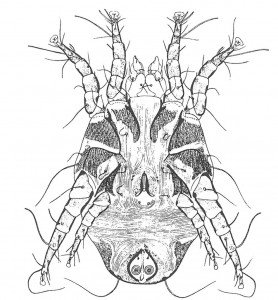

At the beginning of the last century it was discovered that some people have allergic reactions to house dust without being able to find the cause among the then known allergens. House dust allergy was initially considered to be a response to the infected peoples’ own dead skin cells. In 1964, the Dutch physician Reindert Voorhorst reported that he and his team at the University Hospital in Leiden had found mites in house dust, and apparently they were the cause of the disease house dust allergy. The mites found were of the genus Dermatophagoides – which was not widely known back then – and of the species D. pteronyssinus and D.farinae. They are found in nature in birds’ nests and the surrounding environment. They were named house dust mites because they were the cause of the disease house dust allergy, not because they were originally thought to live in house dust.
Soon other researchers declared that the only explanation for the presence of mites in house dust was that they lived and ate loose skin flakes, of which there are many in house dust. This clear statement has since been translated into instructions on what to do to eradicate the mites in infected peoples’ homes. It was said that you should clean more thoroughly, keep the air dry and if necessary use poison to control the pests, but it made no apparent difference as the mites continued to be frequent in the dust samples. Attempts to lock in the mites with special bedding offered no relief for patients.
There may be an explanation as to why the mites do not respond as expected. When house dust is microscoped, it is clear that it is almost exclusively house dust mites’ spreading stages, which are found. In particular, dead, dried specimens, which apparently did not live where they were found. They rarely have intestinal contents, and if they have, it is not the remains of skin flakes that are found. The mites apparently do not feed in our homes (perhaps because they are already dead) and they apparently do not produce excrements, allergens or breed in them either. Consequently, this means that the mites do not live in our homes, but are rather a contamination from outside. This recognition [1] is still quite new and indicates a need for further assessment of the advice provide to house dust allergy patients. The allergens are still in the mite bodies so they are not completely harmless, even if they are dead.
Other mites are also found other in house dust samples. In total, there are about 200 different mite known species, which are occasionally found when examining house dust under a microscope. House dust mite are the most common, however the sugar mite, Glycyphagus domesticus and the Tarsonemus are common. Just like the house dust mites, most of them live in the wild and for reasons unknown, their spreading stages, end up in the air we vacuum through our vacuum cleaners.




